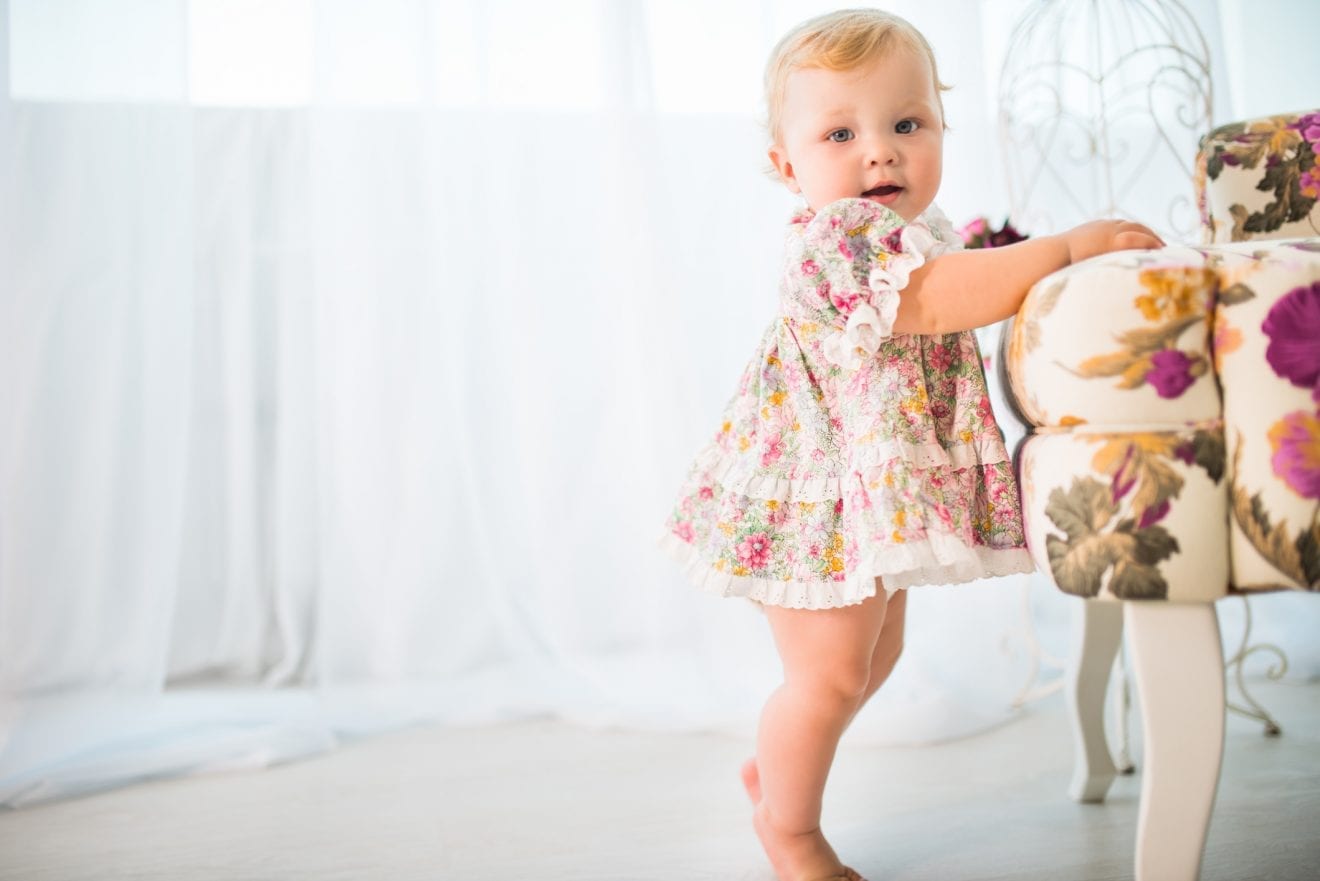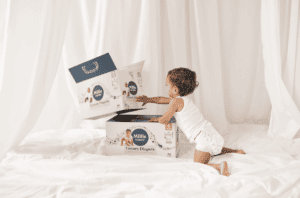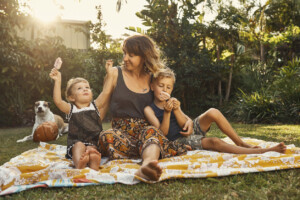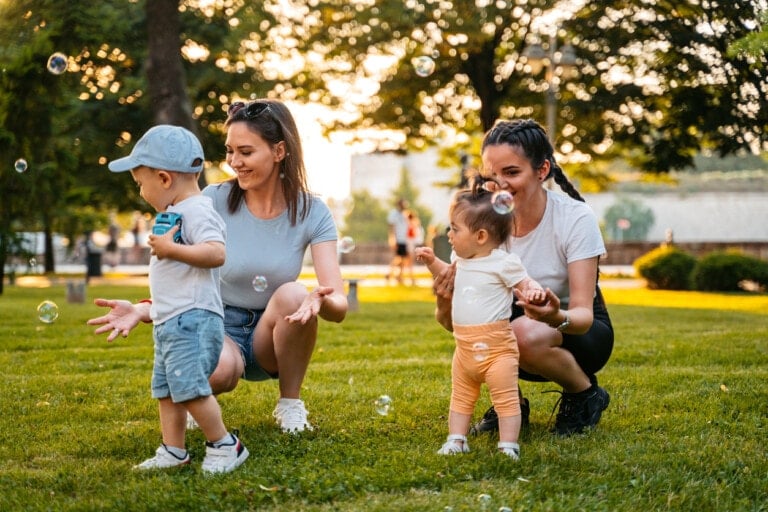Congratulations! You successfully carried this tiny bundle of love for nine long months and then gave birth to an incredibly amazing (yet bewildering) miniature human being. So now what? Unfortunately, babies don’t have instruction manuals, but you can monitor important developmental milestones to ensure your baby is on track.
Remember that the expected ages for meeting developmental milestones are just guidelines. Every child is unique and develops at their own individual pace. Occasionally there will be moments when your baby’s development seems to lag, usually followed by a spurt in progress. Don’t worry if your baby meets some milestones sooner or later than the guidelines suggest. However, let their milestone timeline serve as a guide for illuminating potential red flags. Your pediatrician should monitor your baby’s development at all their well-child checks. This will be an excellent time to discuss any concerns you may have.
Trust your mommy intuition. Share your concerns with your family pediatrician if something doesn’t feel right. They can direct you to the appropriate professional or community resource as needed. A simple screening can confirm whether a child’s developmental milestones are on track, which goes a long way in reassuring nervous parents (like you and me).
Baby at One Month
At one month, your baby can focus eight to twelve inches away from her face. It is normal for her eyes to wander and occasionally cross. She prefers black-and-white or high-contrast patterns. Her hearing is not fully developed. She may turn her head towards familiar sounds, like mommy and daddy’s voices. She can lift her head briefly and turn it side-to-side when on her tummy but still needs head and neck support when upright. Be attentive to these developmental milestones and responsive to her needs. Cuddle her, talk to her, read her books, and play simple games like peekaboo. Truth: you really can’t spoil a newborn! That’s just a parenting myth about babies.
Talk to your family doctor if your child presents any of the following red flags:
- Feeds slowly or doesn’t suck well
- Has trouble focusing her eyes
- Doesn’t react to bright lights
- Seems especially stiff or floppy
- Doesn’t react to loud noises
Baby at Three Months
By three months, you will notice your baby has lost many of their newborn reflexes while acquiring more voluntary control of their body. Your baby actively enjoys playtime, smiles at the sound of your voice and turns their head towards the direction of the sound, has begun babbling and mimicking sounds, and is probably dazzling you daily with her big toothless smile. She no longer needs you to support her head. Tummy time is important. She can lift her head and chest and even do “mini pushups” in preparation for rolling over. She can open and close her hands, grasp and shake toys, swat at dangling objects, bring her hands to her mouth, and push down with her legs when in the standing position. Her hand-eye coordination is improving, as well as her visual coordination and focus. She can now see you from across the room!
Talk to your family doctor if your child presents any of the following red flags:
- Can’t support her head well
- Doesn’t smile at people or ignores new faces
- Doesn’t notice hands, reach for, or grasp objects
- Can’t follow moving objects with their eyes or has trouble moving one or both eyes in all directions
- Doesn’t react to loud noises
- Doesn’t babble
Baby at Four to Seven Months
Baby is on the move! By seven months, she can probably roll to her tummy and back again, sit without assistance, and support her weight with her legs well enough to bounce when you hold her. She will learn to “tripod,” leaning forward as she extends her arms to balance her upper body, followed by sitting without assistance and the support of her hands. Baby uses a raking grasp to pull objects (like toys) closer to her and can transfer them from one hand to another.
She is more sensitive to your tone of voice and probably recognizes her name. Baby may respond to sound by making sounds and using her voice to express joy and displeasure. Her distance vision continues to mature, she can track moving objects, and she has developed full-color vision. She can find partially hidden objects. Your child may cry when you leave the room or a stranger suddenly confronts them. This indicates they are developing a strong attachment to you and other caregivers.
Read to her daily, and provide age-appropriate toys for play and learning. Babies enjoy social play at this age. She is likely to be interested in mirror images. Engage your child in face-to-face talk. Give consistent, warm, physical contact. Spend time on the floor playing with your child every day. Talk and sing to your baby during everyday activities. Point out household items in their everyday context. Engage in rhythmic movement with your child, such as dancing together with music. This is a great time to work on establishing a routine for sleeping, feeding, and playtime — if you haven’t already. Many child development specialists recommend the Eat, Play, Sleep method.
Talk to your family doctor if your child presents any of the following red flags:
- Seems very stiff or floppy
- Can’t hold her head steady
- Can’t roll over in either direction by five to seven months
- Cannot sit with help by six months
- Does not bear some weight on legs by seven months
- Doesn’t respond to noises or spontaneously smile
- Does not laugh or make squealing sounds by six months or babble by eight months
- Isn’t affectionate with those closest to her
- Doesn’t enjoy being around people, shows no interest in games of peekaboo by eight months
- Doesn’t reach for objects or reaches only with one hand
- Has difficulty getting objects to her mouth
- One or both eyes consistently turn in or out
Baby at Eight to Twelve Months
Look at your little explorer go! By eight to twelve months, your baby will be hitting developmental milestones that will have her on the move. You will be surprised at how quickly she can sit without assistance, crawl, and scoot, so don’t forget to babyproof your home! Baby will pull up to standing, may stand momentarily without support, and “cruise” on furniture. She may even take some solo first steps before her first birthday. But know that it is perfectly okay if she doesn’t. Some babies don’t begin walking until closer to 18 months.
Her babbling should sound more like an actual conversation with inflection, and she may begin saying a few words like “mama” and “dada.” She responds to “no” and simple verbal requests and may use simple gestures such as shaking her head for “no.” She pays close attention to your words and gestures to let you know what she wants. Baby uses her thumb and forefinger in a pincer grasp to eat finger foods. She may bang objects together, move objects into/out of a container, and let go of objects voluntarily. She loves to imitate you. Combing her hair, drinking from a cup, finger-feeding herself, and pretending to talk on the phone.
Do not be alarmed: stranger anxiety is normal and separation anxiety may develop at this age. She may be fearful in some situations and prefers her mother or other caregivers over all others. But it makes it a little challenging to leave her in daycare or the nursery at church when she refuses to let go!
Keep talking to her and being attentive to her rhythms and moods. Respond to her when she is upset, as well as when she is happy. Give consistent warm physical contact. This is a critical stage for language development. Keep reading together (always), play peekaboo and pattycake to stimulate your baby’s memory skills, and hide and seek games with toys. Practice walking with her. Offer her crayons and paper, building blocks, and soft toys to help develop her hand-to-eye coordination and fine motor skills. Babies love banging pots and pans! Praise her for good behavior and distract her away from not-so-good behavior or firmly say “no” and remove them from a dangerous situation.
Talk to your family doctor if your child presents any of the following red flags:
- Doesn’t crawl or drags one side of her body while crawling for more than one month
- Can’t stand without support
- Doesn’t try to find objects you’ve hidden while she watches
- Doesn’t use gestures like waving or shaking head
- Does not point to objects or pictures
- Says no single words (“mama” or “dad”)
Intervention is more likely to be effective when implemented early. Be sure to discuss any concerns with your pediatrician and ask for more information on age-appropriate developmental activities for infants and children that you can do in your own home.































